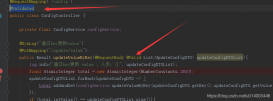动态代理其实就是java.lang.reflect.Proxy类动态的根据您指定的所有接口生成一个class byte,该class会继承Proxy类,并实现所有你指定的接口(您在参数中传入的接口数组);然后再利用您指定的classloader将 class byte加载进系统,最后生成这样一个类的对象,并初始化该对象的一些值,如invocationHandler,以即所有的接口对应的Method成员。 初始化之后将对象返回给调用的客户端。这样客户端拿到的就是一个实现你所有的接口的Proxy对象。请看实例分析:
一 业务接口类
|
1
2
3
|
public interface BusinessProcessor { public void processBusiness();} |
二 业务实现类
|
1
2
3
4
5
|
public class BusinessProcessorImpl implements BusinessProcessor { public void processBusiness() { System.out.println("processing business....."); }} |
三 业务代理类
|
1
2
3
4
5
6
7
8
9
10
11
12
13
14
15
|
import java.lang.reflect.InvocationHandler;import java.lang.reflect.Method;public class BusinessProcessorHandler implements InvocationHandler { private Object target = null; BusinessProcessorHandler(Object target){ this.target = target; } public Object invoke(Object proxy, Method method, Object[] args) throws Throwable { System.out.println("You can do something here before process your business"); Object result = method.invoke(target, args); System.out.println("You can do something here after process your business"); return result; }} |
四 客户端应用类
|
1
2
3
4
5
6
7
8
9
10
11
12
|
import java.lang.reflect.Field;import java.lang.reflect.Method;import java.lang.reflect.Modifier;import java.lang.reflect.Proxy;public class Test { public static void main(String[] args) { BusinessProcessorImpl bpimpl = new BusinessProcessorImpl(); BusinessProcessorHandler handler = new BusinessProcessorHandler(bpimpl); BusinessProcessor bp = (BusinessProcessor)Proxy.newProxyInstance(bpimpl.getClass().getClassLoader(), bpimpl.getClass().getInterfaces(), handler); bp.processBusiness(); }} |
现在我们看一下打印结果:
|
1
2
3
|
You can do something here before process your businessprocessing business.....You can do something here after process your business |
通过结果我们就能够很简单的看出Proxy的作用了,它能够在你的核心业务方法前后做一些你所想做的辅助工作,如log日志,安全机制等等。
现在我们来分析一下上面的类的工作原理。
类一二没什么好说的。先看看类三吧。 实现了InvocationHandler接口的invoke方法。其实这个类就是最终Proxy调用的固定接口方法。Proxy不管客户端的业务方法是怎么实现的。当客户端调用Proxy时,它只会调用InvocationHandler的invoke接口,所以我们的真正实现的方法就必须在invoke方法中去调用。关系如下:
|
1
2
3
4
|
BusinessProcessorImpl bpimpl = new BusinessProcessorImpl(); BusinessProcessorHandler handler = new BusinessProcessorHandler(bpimpl);BusinessProcessor bp = (BusinessProcessor)Proxy.newProxyInstance(....);bp.processBusiness()-->invocationHandler.invoke()-->bpimpl.processBusiness(); |
那么bp到底是怎么样一个对象呢。我们改一下main方法看一下就知道了:
|
1
2
3
4
5
6
7
|
public static void main(String[] args) {BusinessProcessorImpl bpimpl = new BusinessProcessorImpl();BusinessProcessorHandler handler = new BusinessProcessorHandler(bpimpl);BusinessProcessor bp = (BusinessProcessor)Proxy.newProxyInstance(bpimpl.getClass().getClassLoader(), bpimpl.getClass().getInterfaces(), handler);bp.processBusiness();System.out.println(bp.getClass().getName());} |
输出结果:
|
1
2
3
4
|
You can do something here before process your businessprocessing business.....You can do something here after process your business$Proxy0 |
bp原来是个$Proxy0这个类的对象。那么这个类到底是长什么样子呢?好的。我们再写二个方法去把这个类打印出来看个究竟,是什么三头六臂呢?我们在main下面写如下两个静态方法。
|
1
2
3
4
5
6
7
8
9
10
11
12
13
14
15
16
17
18
19
20
21
22
23
24
25
26
27
28
29
30
31
32
33
34
35
36
37
38
39
40
41
42
43
44
45
46
47
48
49
50
51
52
53
54
55
56
57
58
59
60
61
62
63
64
65
66
67
68
69
70
71
72
73
74
75
76
77
78
79
80
81
82
83
84
85
86
87
88
89
90
91
92
93
94
95
96
|
public static String getModifier(int modifier){ String result = ""; switch(modifier){ case Modifier.PRIVATE: result = "private"; case Modifier.PUBLIC: result = "public"; case Modifier.PROTECTED: result = "protected"; case Modifier.ABSTRACT : result = "abstract"; case Modifier.FINAL : result = "final"; case Modifier.NATIVE : result = "native"; case Modifier.STATIC : result = "static"; case Modifier.SYNCHRONIZED : result = "synchronized"; case Modifier.STRICT : result = "strict"; case Modifier.TRANSIENT : result = "transient"; case Modifier.VOLATILE : result = "volatile"; case Modifier.INTERFACE : result = "interface"; } return result; } public static void printClassDefinition(Class clz){ String clzModifier = getModifier(clz.getModifiers()); if(clzModifier!=null && !clzModifier.equals("")){ clzModifier = clzModifier + " "; } String superClz = clz.getSuperclass().getName(); if(superClz!=null && !superClz.equals("")){ superClz = "extends " + superClz; } Class[] interfaces = clz.getInterfaces(); String inters = ""; for(int i=0; i<interfaces.length; i++){ if(i==0){ inters += "implements "; } inters += interfaces[i].getName(); } System.out.println(clzModifier +clz.getName()+" " + superClz +" " + inters ); System.out.println("{"); Field[] fields = clz.getDeclaredFields(); for(int i=0; i<fields.length; i++){ String modifier = getModifier(fields[i].getModifiers()); if(modifier!=null && !modifier.equals("")){ modifier = modifier + " "; } String fieldName = fields[i].getName(); String fieldType = fields[i].getType().getName(); System.out.println(" "+modifier + fieldType + " "+ fieldName + ";"); } System.out.println(); Method[] methods = clz.getDeclaredMethods(); for(int i=0; i<methods.length; i++){ Method method = methods[i]; String modifier = getModifier(method.getModifiers()); if(modifier!=null && !modifier.equals("")){ modifier = modifier + " "; } String methodName = method.getName(); Class returnClz = method.getReturnType(); String retrunType = returnClz.getName(); Class[] clzs = method.getParameterTypes(); String paraList = "("; for(int j=0; j<clzs.length; j++){ paraList += clzs[j].getName(); if(j != clzs.length -1 ){ paraList += ", "; } } paraList += ")"; clzs = method.getExceptionTypes(); String exceptions = ""; for(int j=0; j<clzs.length; j++){ if(j==0){ exceptions += "throws "; } exceptions += clzs[j].getName(); if(j != clzs.length -1 ){ exceptions += ", "; } } exceptions += ";"; String methodPrototype = modifier +retrunType+" "+methodName+paraList+exceptions; System.out.println(" "+methodPrototype ); } System.out.println("}"); } |
再改写main方法
|
1
2
3
4
5
6
7
8
9
|
public static void main(String[] args) {BusinessProcessorImpl bpimpl = new BusinessProcessorImpl();BusinessProcessorHandler handler = new BusinessProcessorHandler(bpimpl);BusinessProcessor bp = (BusinessProcessor)Proxy.newProxyInstance(bpimpl.getClass().getClassLoader(), bpimpl.getClass().getInterfaces(), handler);bp.processBusiness();System.out.println(bp.getClass().getName());Class clz = bp.getClass();printClassDefinition(clz);} |
现在我们再看看输出结果:
|
1
2
3
4
5
6
7
8
9
10
11
12
13
14
15
16
|
You can do something here before process your businessprocessing business.....You can do something here after process your business$Proxy0$Proxy0 extends java.lang.reflect.Proxy implements com.tom.proxy.dynamic.BusinessProcessor{ java.lang.reflect.Method m4; java.lang.reflect.Method m2; java.lang.reflect.Method m0; java.lang.reflect.Method m3; java.lang.reflect.Method m1; void processBusiness(); int hashCode(); boolean equals(java.lang.Object); java.lang.String toString();} |
很明显,Proxy.newProxyInstance方法会做如下几件事:
1,根据传入的第二个参数interfaces动态生成一个类,实现interfaces中的接口,该例中即BusinessProcessor接口的processBusiness方法。并且继承了Proxy类,重写了hashcode,toString,equals等三个方法。具体实现可参看 ProxyGenerator.generateProxyClass(...); 该例中生成了$Proxy0类
2,通过传入的第一个参数classloder将刚生成的类加载到jvm中。即将$Proxy0类load
3,利用第三个参数,调用$Proxy0的$Proxy0(InvocationHandler)构造函数 创建$Proxy0的对象,并且用interfaces参数遍历其所有接口的方法,并生成Method对象初始化对象的几个Method成员变量
4,将$Proxy0的实例返回给客户端。
现在好了。我们再看客户端怎么调就清楚了。
1,客户端拿到的是$Proxy0的实例对象,由于$Proxy0继承了BusinessProcessor,因此转化为BusinessProcessor没任何问题。
|
1
|
BusinessProcessor bp = (BusinessProcessor)Proxy.newProxyInstance(....); |
2,bp.processBusiness();
实际上调用的是$Proxy0.processBusiness();那么$Proxy0.processBusiness()的实现就是通过InvocationHandler去调用invoke方法啦!
总结
以上就是本文关于Java Proxy机制详细解读的全部内容,希望对大家有所帮助。有什么问题可以随时留言,小编会及时回复大家。
原文链接:http://blog.csdn.net/rokii/article/details/4046098















